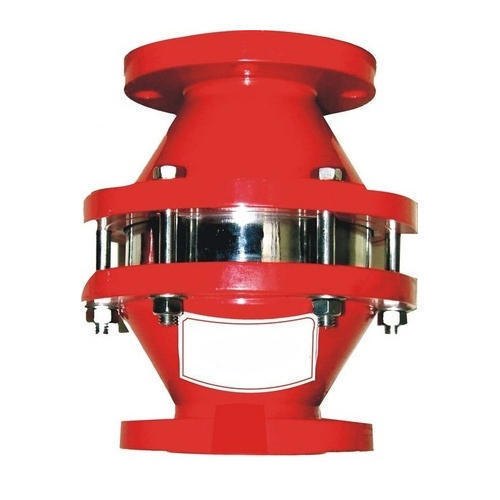Industrial facilities are designed to be safe and to minimize the risk of fire and explosion, many ways are used to do this, primary safety devices such as: isolation valves, hydraulic seals, oxygen analyzers and gas analyzers provide the first line of defense, while flame arrestors provide backup protection in case primary safety devices fail.
flame arrestors are fire safety devices which allow air and flammable gases to pass, but prevent propagation of flames through the device, they are passive safety devices, they have no moving parts and do not require a source of energy to function.
flame arrestors prevent the propagation of a flame front from outside of a storage tank or process vessel to the inside, or of a flame between interconnected items of equipment.
These devices employ a medium, known as the matrix, inside a casing that extinguishes the flame and, when appropriate, stops a shock wave from a detonation. Typical media are crimped-metal-ribbon, expanded metal and parallel plates. There are also proprietary dry-type aresstors, as well as other types of flame arrestors that do not contain a matrix; these find service where conventional dry types are not suitable or expensive.
Among these are hydraulic (liquid-seal) and packed-bed arrestors, velocity flame stoppers, high-velocity vent-valves, and conservation vent-valves.
where Flame Arrestors are Used?
many industries use this important device such as: oil and gas processing and refining, pharmaceutical , pulp and paper, waste and sewage treatment, mining and many others. within these industries, arrestors are used on air intakes on fired heaters, incinerators, boilers, fuel inlet piping to fire boxes, flare systems, tank vents, and vapor recovery types.
read also Flare Types and Components
When an arrestor is located directly on a vessel or tank vent-nozzle, or on the end of a vent line from the vent nozzle, it is called an end-of-line arrestor, and usually is installed to stop deflagrations. These devices are commonly
installed on atmospheric-pressure storage tanks, process vessels and transport containers. If the vented vapors are
ignited accidentally, say by lightning, then the arrestor will prevent the flame from spreading to the inside of the vessel.
Such flame arrestors do not stop detonations. End-offline flame arrestors can be placed on vessels or tanks located
inside buildings and outdoors If the arrestor is not connected to the end of a line, then it can be placed in-line. Such arrestors can be built to withstand deflagrations or detonations (if properly designed for these more-extreme conditions), depending on the length of pipe and pipe configuration on the unprotected side of the arrestor,
and any restrictions on the protected side (e.g., the inclusion of valves or elbows). A detonation flame arrestor is used where the run-up distance (that from the source to the arrestor) is sufficient for a detonation to develop.
Some in-line deflagration flame arrestors are called “pipe-away” or vent-line arrestors. These are also installed
on the vent-nozzles of atmospheric-pressure tanks and vessels, but have a short length of pipe attached to them to direct the vapors, and possibly flames, away from the tank or vessel roof Detonation flame arrestors withstand and extinguish high-speed, high-pressure flame fronts. Therefore, these devices must be able to resist the mechanical effects of detonation shock waves while quenching the flames.
real also Crude Oil Tanks
Some designs have a shock absorber in front of the flame-arresting element to lessen the effect of the high-pressure wave and its dynamic energy, and to split the front before it reaches the arrestor element.
Detonations in piping have velocities of about 6,000 ft/s or more, and, in closed process vessels and equipment,
can generate pressures from 20–100+ times the initial value. When installed in a vent-manifold, these arrestors
on the tanks can be uni- or bidirectional, depending upon the manufacturer’s recommendations. Detonation arrestors preferably should be installed vertically, so if liquid is present, the arrestor will drain. If they must be installed horizontally, drain connections are needed. Most detonation arrestors have crimped-metal-ribbon elements, although expanded-metal cartridges are also used. Detonation arrestor elements are usually longer than the elements used for deflagration arrestors.
Principles of Flame Arrestors Operation:
to effectively quench the flames, arrestors must transfer the heat from the flame to the arrestor and sustain the the heat transfer over a long period of time, this is done by the following steps:
1. Heat Conducting Material :
the arrestor element which absorbs the heat made of a material, such as a metal, or metal-ceramic media that conducts heat.
2. Large Surface Area:
the element exposes the flame to a large-conducting surface area so that a large quantity of the heat transferred to
Classification schemes for dry types
There are various ways to classify dry-type arrestors:
• Deflagration vs. detonation models.
• Direction of flame approach for which the arrestor is designed to operate in a pipe.
The pipe that connects the arrestor with an identified ignition source is known as the unprotected side of the arrestor. The pipe connecting the arrestor to at-risk equipment that must be protected from flame penetration is the protected side.

